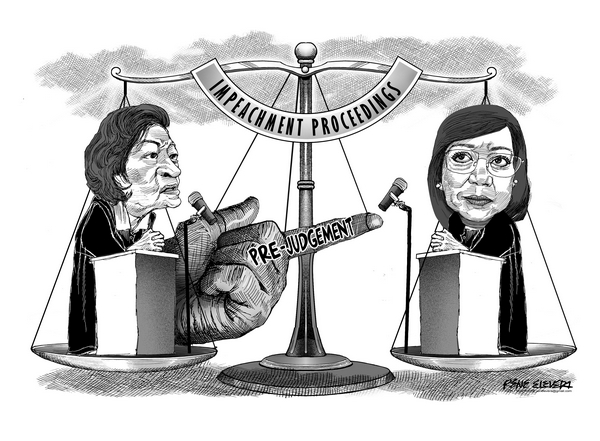
While we have already retraced in this space the connection between the Office of the President and the impeachment complaint, it is time to take a step back and comprehend once more the systematic unfairness that has characterized moves to remove the nation’s first woman top magistrate.
Let us start with the impeachment process at the Lower House.
One of the complaints was filed by Lawyer Lorenzo Gadon. This was the complaint that got verified.
Gadon lied when he swore he had personal knowledge of his allegations against Sereno.
Nevertheless, the House Justice committee refused to dismiss the complaint outright and cite Gadon for perjury.
Committee members instead wasted public time and money fishing for evidence and concocting a case based on testimonies culled from the frustration and disgruntlement of Sereno’s fellow High Court justices.
Is their substance to the case?
No less than former Chief Justice Hilario Davide Jr. in a speech last week at the University of the Philippines Cebu conveyed that the contents of the case are court administrative issues that should not have been exposed to an eager-to-interfere co-equal government branch.
How else was the conduct of the Lower House inquiry unfair?
Lawyers of the Chief Justice were forbidden to cross-examine Gadon even though the congressmen had the option of being magnanimous enough to recognize her party’s entitlement to conduct a cross-examination.
True, the Lower House committee invited Sereno to their proceedings and she held her ground and did not indulge them.
That is because there was no reason for her to make herself vulnerable to a group that has entertained the perjurious.
With all due respect, the members of the Supreme Court caught the virus of bullying Sereno by forcing her to go on leave purportedly to shield the court from siege when in fact it was members who trooped to the Lower House to vent thereby opening wide the judiciary’s gates to interlopers.
Then came the quo warranto petition, during a lull between the Lower and Upper House stages of the impeachment process, when many discerned the weaknesses and flaws of the case.
Worse, those High Court refused to throw out the quo warranto petition when it should have only been acceptable within a year after Sereno’s appointment.
Worst, members of the High Court who testified against Sereno in the Lower House are now judging a case against her.
Nothing could be worse.
The High Court, in entertaining the petition has shown itself questionable at restraint and discretion in exercising its powers.
Should they throw out the Chief Justice through the quo warranto, history will remember their decision as a lynching energized by the magistrates who refused to inhibit themselves from the case.